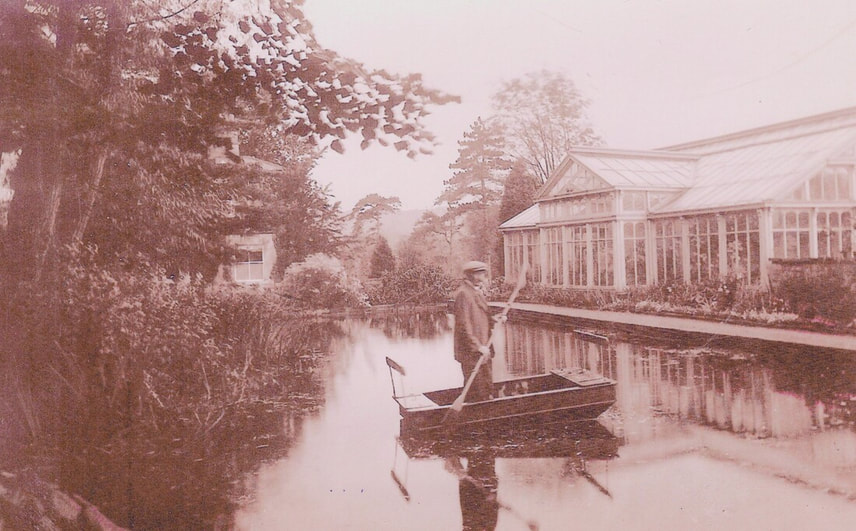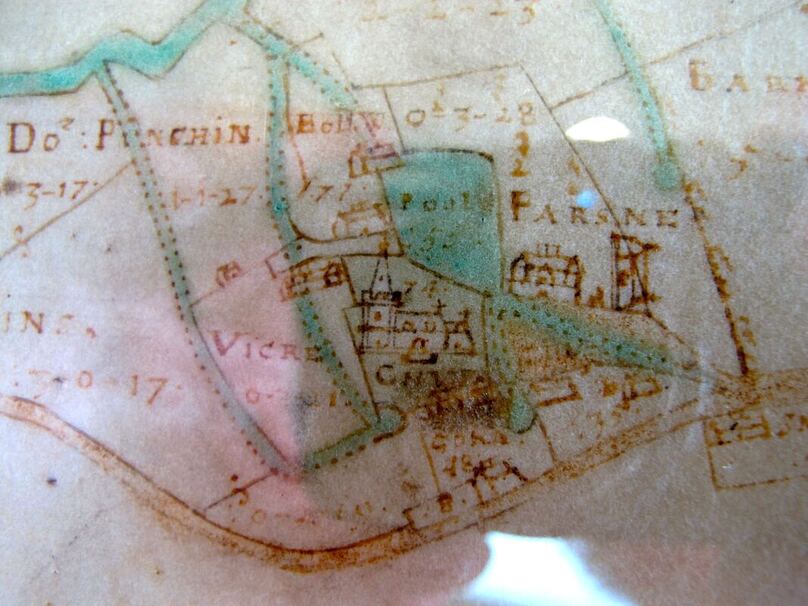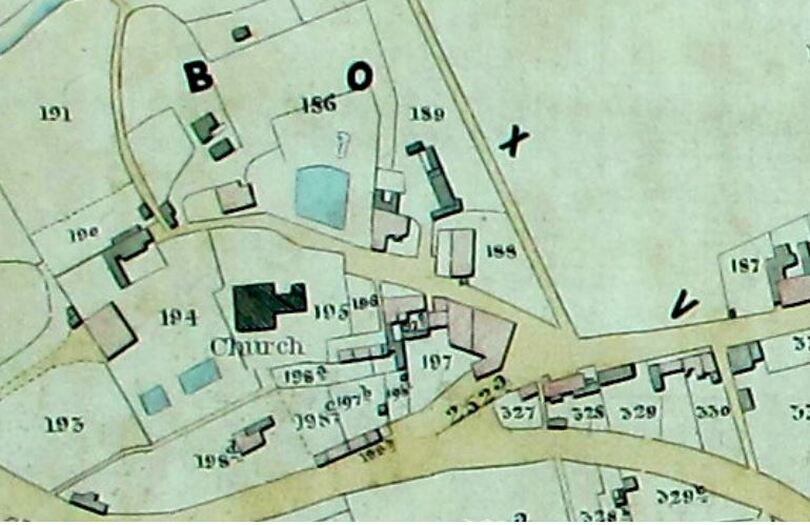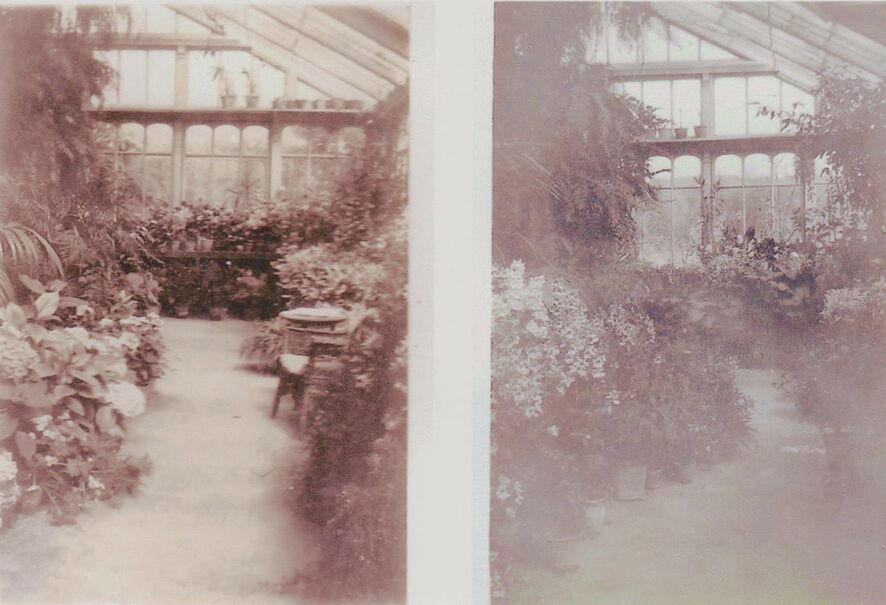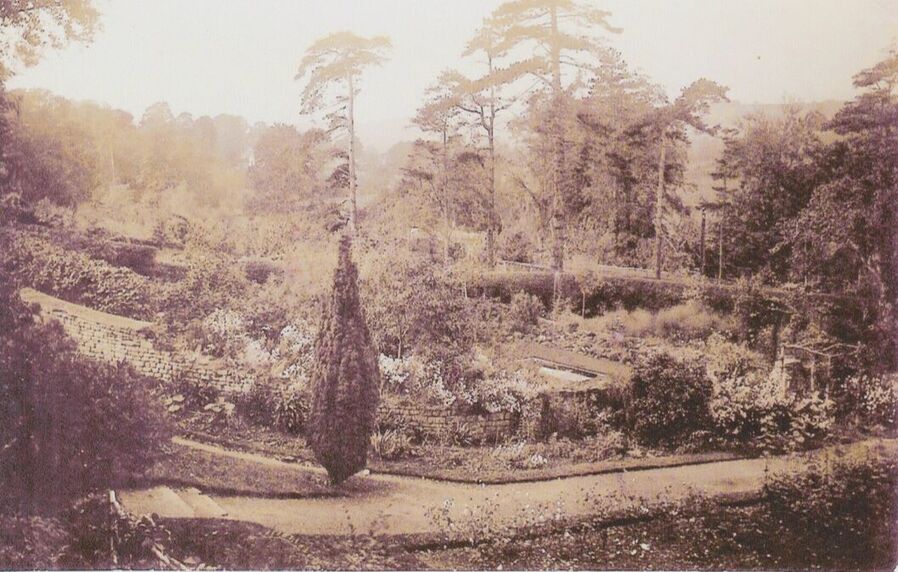The Wilderness History Research Richard Grigsby, April 2019. Unless stated all photos courtesy Richard Grigsby
The Wilderness is a curious name for the property immediately opposite Box Church and central to activities in the early village.
In fact, this was the fourth name of the site: Becket’s Mill, Bollen’s Mill, Church House and then The Wilderness. The Historic Buildings Listing says that the house is a merger of various styles and developments. The date of the original house is unknown (presumed late medieval) and the present property has been altered in the mid-1700s and about 1840.[1] That doesn’t tell us much about this exceptional Grade II listed property and its residents.
By general agreement, the late medieval name of the house was Becket’s Mill House and the area was the location of a watermill (probably a wooden structure) powered by the fast-flowing spring which runs through the area.[2] The assumption is based on various charters dating to the 1100s and 1200s, none of which is definitive. Some believe that the mill was constructed by Monkton Farleigh Priory.[3] Certainly, there was a substantial and, apparently, man-made water area to the east of a house in Francis Allen’s 1626 map.
In fact, this was the fourth name of the site: Becket’s Mill, Bollen’s Mill, Church House and then The Wilderness. The Historic Buildings Listing says that the house is a merger of various styles and developments. The date of the original house is unknown (presumed late medieval) and the present property has been altered in the mid-1700s and about 1840.[1] That doesn’t tell us much about this exceptional Grade II listed property and its residents.
By general agreement, the late medieval name of the house was Becket’s Mill House and the area was the location of a watermill (probably a wooden structure) powered by the fast-flowing spring which runs through the area.[2] The assumption is based on various charters dating to the 1100s and 1200s, none of which is definitive. Some believe that the mill was constructed by Monkton Farleigh Priory.[3] Certainly, there was a substantial and, apparently, man-made water area to the east of a house in Francis Allen’s 1626 map.
There is another confusing matter as the deeds to the property refer to two different mills.[4] There is no way of telling where they were located but it might be strange to have two around the same stretch of lake, so the possibility is that they were on different sides of the house, tapping into different spring courses as shown in Allen’s map.
We are on more secure footing during the time of the Mullins Family of schoolmasters who lived in the house which the first George Mullins had inherited via his wife and her sisters in 1748.[5] In 1766 he acquired a mill which was confirmed in 1780. The name of the mill isn’t recorded and it has been suggested that the mill and the house had become separate entities at this time. This is supported by several terriers (inventories) of customary dues and tithes in the area. The Terrier of 1704 says the dues For Bollen's Mill, one shilling four pence; to be paid at Lady-day.[6] In 1783 the listing was Bollen's Mill (latterly destroyed).
We are on more secure footing during the time of the Mullins Family of schoolmasters who lived in the house which the first George Mullins had inherited via his wife and her sisters in 1748.[5] In 1766 he acquired a mill which was confirmed in 1780. The name of the mill isn’t recorded and it has been suggested that the mill and the house had become separate entities at this time. This is supported by several terriers (inventories) of customary dues and tithes in the area. The Terrier of 1704 says the dues For Bollen's Mill, one shilling four pence; to be paid at Lady-day.[6] In 1783 the listing was Bollen's Mill (latterly destroyed).
Roman Mosaic
By the 1840s we have more names of the house. In the Tithe Apportionment maps of 1840, Rev George Mullins was listed as the occupier of plot 186, a home, garden and outbuildings. The mill pond of the old Becket’s Mill was still prominent on the map.
A year later the house was recorded under the name Church Yard House (often abbreviated to Church House) where Rev George lived with his wife Suzanna and their four children, five pupils and six teachers. This seems a large number of people and begs the question whether anyone slept in the basement of what was by then a large house with three storeys above the basement. It was Rev Mullins who confirmed the existence of the Roman Villa in the grounds of the house when he unearthed a tessellated pavement (mosaic) there in 1831. He later described his finds including a pavement, nearly perfect, apparently forming a passage from some part of the building. It is nine feet wide, twenty-eight feet long … it evidently extended much further in both directions.[7] The relevance of the find was not fully recognised for the next 70 years.
On the death of the father of Rev George in 1841, the house was put up for auction but it didn’t sell, and Mary Miller (possibly distant relative and beneficiary) took over the title to the property.[8] It is probable that the house was then let and possibly was the property referred to as The Churchyard in the 1851 census and occupied by Dr Joseph Goldstone surgeon and general practitioner. We might speculate that the asylum had taken a tenancy of the property because in 1853 Dr Joseph Nash of Kingsdown Asylum and his wife lived in The Wilderness.[9] This date is important in changing the name of the house. In 1853 the Old Parsonage House burnt down and was replaced by Box House, a very grand property owned by Rev Horlock who probably wanted to reserve Church House for possible use himself. It was a short-term lease and by 1857 the family had moved into Kingsdown House.[10] In 1860 H Syer Cuming reported: My garden is full of Roman remains—tiles somewhat ornamented, but broken, bricks, tessellated pavement, fused iron, &c. I send all away to mend the roads; they are a perfect nuisance. We cannot put a spade into the ground without bringing up these impediments to vegetable growth. So much for historic importance!
The next view we have of the property was in 1861 when Rev Henry Nassau Rynd (1821 – 1890) was recorded there. He was born in Ireland, aged 40, and had graduated from Trinity College Dublin. Ordained in 1845, he was a clergyman without cure of souls (no parish) in 1861. His wife Elizabeth (nee Kennedy) was absent on census night and his unmarried sister, Eliza 37, and 5 resident servants were there: a lady’s maid for Mrs Rynd, nursemaid for the children, gardener, cook and maid-of-all-work, Mary Ann Hoskins, 20. Rev Rynd wasn’t in Box long – in 1860 he was still officiating as curate in weddings at Stockbridge, Hampshire, and by 1867 was appointed to a ministry at Shinfield, Berkshire, where he lived for the next 23 years. He probably came to the area because it was close to Bath. Although born in Guernsey, his wife and her sister Joanna Parke lived at 30 Royal Circus, Bath, from where Elizabeth married Henry Nassau at Walcott Church in 1851.
In 1865 Rev Rynd vacated the property and the house was offered for sale by the trustees of WA Hooper.[11] This probably was William Hooper of Walcott, Bath, Landed Proprietor, an Exeter builder and property speculator who made a fortune when he sold Mount Radford Park, once owned by a director of Barings Bank, for housing. The Wilderness may not have sold as in 1867 it was advertised to let unfurnished.[12] It was recorded as Four sitting rooms, nine bedrooms, kitchen and offices … stables for three horses, paddock, fishpond etc. It was taken by Jane Browning (School mistress) and her sister Eliza (teacher), sometimes known as Elizabeth. The sisters were the unmarried daughters of Thomas Browning of Drewetts Mill. The house was too big for them so in April 1868 they advertised a drawing room with one or two bedrooms to let either furnished or unfurnished.[13] Later that year they advertised the building as a Ladies School including little boys under 10 years of age.[14] Their timing was bad as the Box New Schools were opened in 1875. In 1881 the house was occupied by stone quarryman George Newman aged 32 and his wife Elizabeth, dressmaker. They weren’t the principal tenants, only lodgers, and unfortunately it isn’t possible to identify the head of household.
By the 1840s we have more names of the house. In the Tithe Apportionment maps of 1840, Rev George Mullins was listed as the occupier of plot 186, a home, garden and outbuildings. The mill pond of the old Becket’s Mill was still prominent on the map.
A year later the house was recorded under the name Church Yard House (often abbreviated to Church House) where Rev George lived with his wife Suzanna and their four children, five pupils and six teachers. This seems a large number of people and begs the question whether anyone slept in the basement of what was by then a large house with three storeys above the basement. It was Rev Mullins who confirmed the existence of the Roman Villa in the grounds of the house when he unearthed a tessellated pavement (mosaic) there in 1831. He later described his finds including a pavement, nearly perfect, apparently forming a passage from some part of the building. It is nine feet wide, twenty-eight feet long … it evidently extended much further in both directions.[7] The relevance of the find was not fully recognised for the next 70 years.
On the death of the father of Rev George in 1841, the house was put up for auction but it didn’t sell, and Mary Miller (possibly distant relative and beneficiary) took over the title to the property.[8] It is probable that the house was then let and possibly was the property referred to as The Churchyard in the 1851 census and occupied by Dr Joseph Goldstone surgeon and general practitioner. We might speculate that the asylum had taken a tenancy of the property because in 1853 Dr Joseph Nash of Kingsdown Asylum and his wife lived in The Wilderness.[9] This date is important in changing the name of the house. In 1853 the Old Parsonage House burnt down and was replaced by Box House, a very grand property owned by Rev Horlock who probably wanted to reserve Church House for possible use himself. It was a short-term lease and by 1857 the family had moved into Kingsdown House.[10] In 1860 H Syer Cuming reported: My garden is full of Roman remains—tiles somewhat ornamented, but broken, bricks, tessellated pavement, fused iron, &c. I send all away to mend the roads; they are a perfect nuisance. We cannot put a spade into the ground without bringing up these impediments to vegetable growth. So much for historic importance!
The next view we have of the property was in 1861 when Rev Henry Nassau Rynd (1821 – 1890) was recorded there. He was born in Ireland, aged 40, and had graduated from Trinity College Dublin. Ordained in 1845, he was a clergyman without cure of souls (no parish) in 1861. His wife Elizabeth (nee Kennedy) was absent on census night and his unmarried sister, Eliza 37, and 5 resident servants were there: a lady’s maid for Mrs Rynd, nursemaid for the children, gardener, cook and maid-of-all-work, Mary Ann Hoskins, 20. Rev Rynd wasn’t in Box long – in 1860 he was still officiating as curate in weddings at Stockbridge, Hampshire, and by 1867 was appointed to a ministry at Shinfield, Berkshire, where he lived for the next 23 years. He probably came to the area because it was close to Bath. Although born in Guernsey, his wife and her sister Joanna Parke lived at 30 Royal Circus, Bath, from where Elizabeth married Henry Nassau at Walcott Church in 1851.
In 1865 Rev Rynd vacated the property and the house was offered for sale by the trustees of WA Hooper.[11] This probably was William Hooper of Walcott, Bath, Landed Proprietor, an Exeter builder and property speculator who made a fortune when he sold Mount Radford Park, once owned by a director of Barings Bank, for housing. The Wilderness may not have sold as in 1867 it was advertised to let unfurnished.[12] It was recorded as Four sitting rooms, nine bedrooms, kitchen and offices … stables for three horses, paddock, fishpond etc. It was taken by Jane Browning (School mistress) and her sister Eliza (teacher), sometimes known as Elizabeth. The sisters were the unmarried daughters of Thomas Browning of Drewetts Mill. The house was too big for them so in April 1868 they advertised a drawing room with one or two bedrooms to let either furnished or unfurnished.[13] Later that year they advertised the building as a Ladies School including little boys under 10 years of age.[14] Their timing was bad as the Box New Schools were opened in 1875. In 1881 the house was occupied by stone quarryman George Newman aged 32 and his wife Elizabeth, dressmaker. They weren’t the principal tenants, only lodgers, and unfortunately it isn’t possible to identify the head of household.
Wilderness Gardens
For nearly thirty years from 1890 until 1917, the house was owned by Miss Mary Anne Margaret Burges, born in Tyrone, Ireland in 1840. When she left the property and sold her furniture, her possessions included a quantity of ferns and greenhouse plants.[15] At this point, the house may have been occupied by the King family but nothing more is known of their time here.[16]
In the period from the 1920s until the mid-war years, the house was the home of Mrs Louisa Secker (28 December 1861 - 1947), widow, who lived quietly there with a companion Miss Edith Walker and a cook and parlour maid. She did her bit for the war effort in the village as befitted an elderly widow, donating triangular bandages and supporting local charitable efforts with money.[17] She was a keen horticulturalist and gardener, who often awarded the prizes in gardening competitions and opened her gardens to visitors for admission of sixpence for the Church Sunday School.[18] In March 1936 Mrs Secker gifted to Box Church some beautifully worked white Alms Bags … a work of art in themselves and a welcome addition to the (Church’s) store of exquisite needlework.[19]
Amazingly, we have details of the head gardener at the house, William Batterbury (1846 - 1933), whose daughter Miss Helen Batterbury was well-known as a supporter of Rev George Foster and Box Church.[20] William and his family lived in Ashley, close to Ashley Villas, for many years before moving to Rosebank, Devizes Road, sometime before 1901, where his earnings as a gardener at The Wilderness were sufficient to fund the rent. It is reputed to be him in the headline photograph inspecting the lake for maintenance. The house then went through a number of different owners and the property’s contents were sold in 1948, possibly following the death of Mrs Secker.[21]
In 1955 Dr Walter Hamis Glover (12 November 1882 – 1963) bought the house.[22] His arrival in Box coincided with that of Rev Tom Selwyn-Smith who was appointed to the ministry at Box in 1955. Vicar Tom visited his new neighbours and recorded a social event after Evensong, much affected by the beauty of the property: We found (The Wilderness) to be a place of ordered beauty, well-watered by the stream; the trees, the fall of the lawns, the borders with phlox at their best and much else; the trout pond and the preserved pavements and wall of the Roman Villa that once stood there, made it a place of tremendous interest to young and old alike.[23]
As far as I have been able to ascertain, Dr Glover came from Royal Lemington Spa, where he worked as Director and Chief Chemist for Courtaulds in 1939. Presumably he and his wife retired to Box. The Glovers took an active part in Box activities, particularly Olive Glover. Mrs Glover worked for the Red Cross efforts to Help the War Disabled, presented cups at events like the St John’s Ambulance Area Competition in 1956 and opened the Church Fete at Fogleigh House in 1959.[24] Dr Glover died here 17 October 1963 aged eighty, and by the late 1960s, his widow Olive had sold to Frank Rhys Hughes.
For nearly thirty years from 1890 until 1917, the house was owned by Miss Mary Anne Margaret Burges, born in Tyrone, Ireland in 1840. When she left the property and sold her furniture, her possessions included a quantity of ferns and greenhouse plants.[15] At this point, the house may have been occupied by the King family but nothing more is known of their time here.[16]
In the period from the 1920s until the mid-war years, the house was the home of Mrs Louisa Secker (28 December 1861 - 1947), widow, who lived quietly there with a companion Miss Edith Walker and a cook and parlour maid. She did her bit for the war effort in the village as befitted an elderly widow, donating triangular bandages and supporting local charitable efforts with money.[17] She was a keen horticulturalist and gardener, who often awarded the prizes in gardening competitions and opened her gardens to visitors for admission of sixpence for the Church Sunday School.[18] In March 1936 Mrs Secker gifted to Box Church some beautifully worked white Alms Bags … a work of art in themselves and a welcome addition to the (Church’s) store of exquisite needlework.[19]
Amazingly, we have details of the head gardener at the house, William Batterbury (1846 - 1933), whose daughter Miss Helen Batterbury was well-known as a supporter of Rev George Foster and Box Church.[20] William and his family lived in Ashley, close to Ashley Villas, for many years before moving to Rosebank, Devizes Road, sometime before 1901, where his earnings as a gardener at The Wilderness were sufficient to fund the rent. It is reputed to be him in the headline photograph inspecting the lake for maintenance. The house then went through a number of different owners and the property’s contents were sold in 1948, possibly following the death of Mrs Secker.[21]
In 1955 Dr Walter Hamis Glover (12 November 1882 – 1963) bought the house.[22] His arrival in Box coincided with that of Rev Tom Selwyn-Smith who was appointed to the ministry at Box in 1955. Vicar Tom visited his new neighbours and recorded a social event after Evensong, much affected by the beauty of the property: We found (The Wilderness) to be a place of ordered beauty, well-watered by the stream; the trees, the fall of the lawns, the borders with phlox at their best and much else; the trout pond and the preserved pavements and wall of the Roman Villa that once stood there, made it a place of tremendous interest to young and old alike.[23]
As far as I have been able to ascertain, Dr Glover came from Royal Lemington Spa, where he worked as Director and Chief Chemist for Courtaulds in 1939. Presumably he and his wife retired to Box. The Glovers took an active part in Box activities, particularly Olive Glover. Mrs Glover worked for the Red Cross efforts to Help the War Disabled, presented cups at events like the St John’s Ambulance Area Competition in 1956 and opened the Church Fete at Fogleigh House in 1959.[24] Dr Glover died here 17 October 1963 aged eighty, and by the late 1960s, his widow Olive had sold to Frank Rhys Hughes.
Box Roman Villa
The story of The Wilderness took a different turn in 1967 when foundations for the Selwyn Hall were excavated and new insights made into the extent of the Roman Villa under the grounds of the Vicarage and The Wilderness gardens. Dr Henry Hurst led the excavation to establish a chronology for the main part of the site, and if possible, to fit into it the evidence from the previous season's work of a fourth century addition to the villa.[25] Suddenly the possibility of more finds in The Wilderness gardens became real.
Frank Hughes took the project under his initiative. He had a great interest in the Roman history of the area and agreed to be the first chairman of Box NATS (Natural History and Archaeological Society) when this was formed in 1969. Interestingly, when an agreement was made on 20 December 1971 with the Calne and District Rural District Council over a television relay station, the old name Becket Mill was used for the site. When Frank Hughes was unable to continue as NATS chairman in 1979 he was promoted to president. Later a tree was planted at the top of the Rec in his memory. Richard and Kate Carless bought the house in about 1980 and Kate continued the archaeological work, excavating a ditch in the nearby Hermitage garden and reinterpreting much of the house’s story. Since then, there have been a number of small trench excavations of the Box Roman Villa.
The Wilderness isn’t a mansion or manor house and it certainly has had moments when it came close to ruin, which may have contributed to its present name. But it does qualify as one of the properties with the most varied history in the whole of Box including a medieval mill site and garden nursery. It has also had some of the most interesting residents ever to come to Box.
The story of The Wilderness took a different turn in 1967 when foundations for the Selwyn Hall were excavated and new insights made into the extent of the Roman Villa under the grounds of the Vicarage and The Wilderness gardens. Dr Henry Hurst led the excavation to establish a chronology for the main part of the site, and if possible, to fit into it the evidence from the previous season's work of a fourth century addition to the villa.[25] Suddenly the possibility of more finds in The Wilderness gardens became real.
Frank Hughes took the project under his initiative. He had a great interest in the Roman history of the area and agreed to be the first chairman of Box NATS (Natural History and Archaeological Society) when this was formed in 1969. Interestingly, when an agreement was made on 20 December 1971 with the Calne and District Rural District Council over a television relay station, the old name Becket Mill was used for the site. When Frank Hughes was unable to continue as NATS chairman in 1979 he was promoted to president. Later a tree was planted at the top of the Rec in his memory. Richard and Kate Carless bought the house in about 1980 and Kate continued the archaeological work, excavating a ditch in the nearby Hermitage garden and reinterpreting much of the house’s story. Since then, there have been a number of small trench excavations of the Box Roman Villa.
The Wilderness isn’t a mansion or manor house and it certainly has had moments when it came close to ruin, which may have contributed to its present name. But it does qualify as one of the properties with the most varied history in the whole of Box including a medieval mill site and garden nursery. It has also had some of the most interesting residents ever to come to Box.
References
[1] Historic Buildings
[2] See Richard Hodges, Box Parish, A Short History, 1975; Clare Higgens, Box Wiltshire, An Intimate History, 1985, p.17; David Ibberson, The Box Collection Vol 2, 1989, p.11; and David Ibberson, The Vicars of St Thomas a Becket, Box, 1987, p.4
[3] Ken Watts, The Wiltshire Cotswolds, 2007, The Hobnob Press, p.195
[4] Courtesy Kate Carless
[5] See Rev George Mullins
[6] Religion in Box
[7] Reported by Rev EH Goddard in Wiltshire Archaeological and Natural History Society, Vol XXVI, 1892, p.405-08
[8] Mullins Family
[9] The Wiltshire Independent, 14 April 1853
[10] The Wiltshire Independent, 26 March 1857
[11] Bath Chronicle and Weekly Gazette, 28 September 1865
[12] Bath Chronicle and Weekly Gazette, 18 July 1867
[13] Bath Chronicle and Weekly Gazette, 16 April 1868
[14] Bath Chronicle and Weekly Gazette, 13 August 1868
[15] The Wiltshire Times, 21 July 1917
[16] Parish Magazine, August 1955
[17] Parish Magazine, February 1940 and August 1940
[18] Parish Magazine August 1932 and Wiltshire Times and Trowbridge Advertiser, 18 July 1936
[19] Parish Magazine, March 1936
[20] The Wiltshire Times, 6 July 1935
[21] The Wiltshire Times, 13 March 1948
[22] Parish Magazine, September 1955
[23] Parish Magazine, September 1955
[24] Wiltshire Times and Trowbridge Advertiser, 9 April 1955 and 6 October 1956 and Parish Magazine, September 1959
[25] Wiltshire Archaeological and Natural History Society, 1969
[1] Historic Buildings
[2] See Richard Hodges, Box Parish, A Short History, 1975; Clare Higgens, Box Wiltshire, An Intimate History, 1985, p.17; David Ibberson, The Box Collection Vol 2, 1989, p.11; and David Ibberson, The Vicars of St Thomas a Becket, Box, 1987, p.4
[3] Ken Watts, The Wiltshire Cotswolds, 2007, The Hobnob Press, p.195
[4] Courtesy Kate Carless
[5] See Rev George Mullins
[6] Religion in Box
[7] Reported by Rev EH Goddard in Wiltshire Archaeological and Natural History Society, Vol XXVI, 1892, p.405-08
[8] Mullins Family
[9] The Wiltshire Independent, 14 April 1853
[10] The Wiltshire Independent, 26 March 1857
[11] Bath Chronicle and Weekly Gazette, 28 September 1865
[12] Bath Chronicle and Weekly Gazette, 18 July 1867
[13] Bath Chronicle and Weekly Gazette, 16 April 1868
[14] Bath Chronicle and Weekly Gazette, 13 August 1868
[15] The Wiltshire Times, 21 July 1917
[16] Parish Magazine, August 1955
[17] Parish Magazine, February 1940 and August 1940
[18] Parish Magazine August 1932 and Wiltshire Times and Trowbridge Advertiser, 18 July 1936
[19] Parish Magazine, March 1936
[20] The Wiltshire Times, 6 July 1935
[21] The Wiltshire Times, 13 March 1948
[22] Parish Magazine, September 1955
[23] Parish Magazine, September 1955
[24] Wiltshire Times and Trowbridge Advertiser, 9 April 1955 and 6 October 1956 and Parish Magazine, September 1959
[25] Wiltshire Archaeological and Natural History Society, 1969
